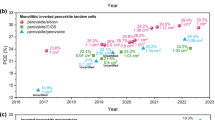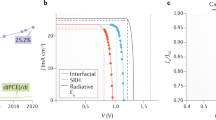Abstract
The upscaling of perovskite solar cells to module scale and long-term stability have been recognized as the most important challenges for the commercialization of this emerging photovoltaic technology. In a perovskite solar module, each interface within the device contributes to the efficiency and stability of the module. Here, we employed a holistic interface stabilization strategy by modifying all the relevant layers and interfaces, namely the perovskite layer, charge transporting layers and device encapsulation, to improve the efficiency and stability of perovskite solar modules. The treatments were selected for their compatibility with low-temperature scalable processing and the module scribing steps. Our unencapsulated perovskite solar modules achieved a reverse-scan efficiency of 16.6% for a designated area of 22.4 cm2. The encapsulated perovskite solar modules, which show efficiencies similar to the unencapsulated one, retained approximately 86% of the initial performance after continuous operation for 2,000 h under AM1.5G light illumination, which translates into a T90 lifetime (the time over which the device efficiency reduces to 90% of its initial value) of 1,570 h and an estimated T80 lifetime (the time over which the device efficiency reduces to 80% of its initial value) of 2,680 h.
This is a preview of subscription content, access via your institution
Access options
Access Nature and 54 other Nature Portfolio journals
Get Nature+, our best-value online-access subscription
$29.99 / 30 days
cancel any time
Subscribe to this journal
Receive 12 digital issues and online access to articles
$119.00 per year
only $9.92 per issue
Buy this article
- Purchase on Springer Link
- Instant access to full article PDF
Prices may be subject to local taxes which are calculated during checkout





Similar content being viewed by others
Data availability
All data generated or analysed during this study are included in the published article and its Supplementary Information. The data that support the plots within this article and other findings of this study are available from the corresponding author upon reasonable request. Source data are provided with this paper.
References
Best-Research-Cell Efficiencies (National Renewable Energy Laboratory, 2020); https://www.nrel.gov/pv/assets/pdfs/best-research-cell-efficiencies.20200406.pdf
Li, Z. et al. Scalable fabrication of perovskite solar cells. Nat. Rev. Mater. 3, 18017 (2018).
Kim, D. H., Whitaker, J. B., Li, Z., van Hest, M. F. A. M. & Zhu, K. Outlook and challenges of perovskite solar cells toward terawatt-scale photovoltaic module technology. Joule 2, 1437–1451 (2018).
Qiu, L., He, S., Ono, L. K., Liu, S. & Qi, Y. B. Scalable fabrication of metal halide perovskite solar cells and modules. ACS Energy Lett. 4, 2147–2167 (2019).
Ono, L. K., Qi, Y. B. & Liu, S. Progress toward stable lead halide perovskite solar cells. Joule 2, 1961–1990 (2018).
Correa-Baena, J.-P. et al. Promises and challenges of perovskite solar cells. Science 358, 739–744 (2017).
Domanski, K., Alharbi, E. A., Hagfeldt, A., Grätzel, M. & Tress, W. Systematic investigation of the impact of operation conditions on the degradation behaviour of perovskite solar cells. Nat. Energy 3, 61–67 (2018).
Saliba, M., Stolterfoht, M., Wolff, C. M., Neher, D. & Abate, A. Measuring aging stability of perovskite solar cells. Joule 2, 1019–1024 (2018).
Khenkin, M. V. et al. Consensus statement for stability assessment and reporting for perovskite photovoltaics based on ISOS procedures. Nat. Energy 5, 35–49 (2020).
Saliba, M. et al. Incorporation of rubidium cations into perovskite solar cells improves photovoltaic performance. Science 354, 206–209 (2016).
Wang, Z. et al. Efficient ambient-air-stable solar cells with 2D–3D heterostructured butylammonium-caesium-formamidinium lead halide perovskites. Nat. Energy 6, 17135 (2017).
Wang, L. et al. A Eu3+-Eu2+ ion redox shuttle imparts operational durability to Pb-I perovskite solar cells. Science 363, 265–270 (2019).
Bai, S. et al. Planar perovskite solar cells with long-term stability using ionic liquid additives. Nature 571, 245–250 (2019).
Yang, S. et al. Stabilizing halide perovskite surfaces for solar cell operation with wide-bandgap lead oxysalts. Science 365, 473–478 (2019).
Fang, R. et al. [6,6]-Phenyl-C61-butyric acid methyl ester/cerium oxide bilayer structure as efficient and stable electron transport layer for inverted perovskite solar cells. ACS Nano 12, 2403–2414 (2018).
Jung, E. H. et al. Efficient, stable and scalable perovskite solar cells using poly(3-hexylthiophene). Nature 567, 511–515 (2019).
Wu, S. et al. A chemically inert bismuth interlayer enhances long-term stability of inverted perovskite solar cells. Nat. Commun. 10, 1161 (2019).
Cheacharoen, R. et al. Encapsulating perovskite solar cells to withstand damp heat and thermal cycling. Sustain. Energy Fuels 2, 2398–2406 (2018).
Yang, M. et al. Highly efficient perovskite solar modules by scalable fabrication and interconnection optimization. ACS Energy Lett. 3, 322–328 (2018).
Matteocci, F. et al. High efficiency photovoltaic module based on mesoscopic organometal halide perovskite. Prog. Photovolt: Res. Appl. 24, 436–445 (2016).
Bi, E. et al. Efficient perovskite solar cell modules with high stability enabled by iodide diffusion barriers. Joule 3, 1–13 (2019).
Bu, T. et al. Universal passivation strategy to slot-die printed SnO2 for hysteresis-free efficient flexible perovskite solar module. Nat. Commun. 9, 4609 (2018).
Xu, Z. et al. A thermodynamically favored crystal orientation in mixed formamidinium/methylammonium perovskite for efficient solar cells. Adv. Mater. 31, 1900390 (2019).
Jiang, Q. et al. Enhanced electron extraction using SnO2 for high-efficiency planar-structure HC(NH2)2PbI3-based perovskite solar cells. Nat. Energy 1, 16177 (2016).
Qiu, L. et al. Scalable fabrication of stable high efficiency perovskite solar cells and modules utilizing room temperature sputtered SnO2 electron transport layer. Adv. Funct. Mater. 29, 1806779 (2019).
Brinkmann, K. O. et al. Suppressed decomposition of organometal halide perovskites by impermeable electron-extraction layers in inverted solar cells. Nat. Commun. 8, 13938 (2017).
Yang, D. et al. High efficiency planar-type perovskite solar cells with negligible hysteresis using EDTA-complexed SnO2. Nat. Commun. 9, 3239 (2018).
Li, X., Zhang, W., Wang, X., Gao, F. & Fang, J. Disodium edetate as a promising interfacial material for inverted organic solar cells and the device performance optimization. ACS Appl. Mater. Interfaces 6, 20569–20573 (2014).
Son, D.-Y. et al. Universal approach toward hysteresis-free perovskite solar cell via defect engineering. J. Am. Chem. Soc. 140, 1358–1364 (2018).
Wu, W.-Q. et al. Bilateral alkylamine for suppressing charge recombination and improving stability in blade-coated perovskite solar cells. Sci. Adv. 5, eaav8925 (2019).
Liu, Z. et al. Gas-solid reaction based over one-micrometer thick stable perovskite films for efficient solar cells and modules. Nat. Commun. 9, 3880 (2018).
Im, J.-H., Chung, J., Kim, S.-J. & Park, N.-G. Synthesis, structure, and photovoltaic property of a nanocrystalline 2H perovskite-type novel sensitizer (CH3CH2NH3)PbI3. Nanoscale Res. Lett. 7, 353 (2012).
Peng, W. et al. Engineering of CH3NH3PbI3 perovskite crystals by alloying large organic cations for enhanced thermal stability and transport properties. Angew. Chem. Int. Ed. 55, 10686–10690 (2016).
Zhou, J. et al. Efficient ambient-air-stable HTM-free carbon-based perovskite solar cells with hybrid 2D–3D lead halide photoabsorbers. J. Mater. Chem. A 6, 22626–22635 (2018).
Zhang, Y., Kim, S.-G., Lee, D., Shin, H. & Park, N.-G. Bifacial stamping for high efficiency perovskite solar cells. Energy Environ. Sci. 12, 308–321 (2019).
Gholipour, S. et al. Globularity-selected large molecules for a new generation of multication perovskites. Adv. Mater. 29, 1702005 (2017).
Wang, Y. et al. A mixed-cation lead iodide MA1−xEAxPbI3 absorber for perovskite solar cells. J. Energy Chem. 27, 215–218 (2018).
Luo, D. et al. Enhanced photovoltage for inverted planar heterojunction perovskite solar cells. Science 360, 1442–1446 (2018).
Jiang, Y. et al. Combination of hybrid CVD and cation exchange for upscaling Cs-substituted mixed cation perovskite solar cells with high efficiency and stability. Adv. Funct. Mater. 28, 1703835 (2017).
Christians, J. A. et al. Tailored interfaces of unencapsulated perovskite solar cells for >1,000 hour operational stability. Nat. Energy 3, 68–74 (2018).
Kim, G.-W., Kang, G., Malekshahi Byranvand, M., Lee, G.-Y. & Park, T. Gradated mixed hole transport layer in a perovskite solar cell: improving moisture stability and efficiency. ACS Appl. Mater. Interfaces 9, 27720–27726 (2017).
Domanski, K. et al. Not all that glitters is gold: metal-migration-induced degradation in perovskite solar cells. ACS Nano 10, 6306–6314 (2016).
Jinno, H. et al. Stretchable and waterproof elastomer-coated organic photovoltaics for washable electronic textile applications. Nat. Energy 2, 780–785 (2017).
Acknowledgements
This work was supported by funding from the Energy Materials and Surface Sciences Unit of the Okinawa Institute of Science and Technology Graduate University, the OIST R&D Cluster Research Program and the OIST Proof of Concept (POC) Program. We thank OIST Mechanical Engineering & Microfabrication Support Section for maintenance of the cleanroom and parylene deposition equipment. The authors thank M. Remeika for writing the software for steady-state power measurements and H. B. Kang, N. Ishizu, T. Miyazawa, the OIST Imaging Section and the Nanofab team for XRD, SEM, AFM and TRPL characterization.
Author information
Authors and Affiliations
Contributions
Y.Q. supervised the project. Y.Q. and Z.L. conceived the ideas and designed the experiments. Z.L. conducted the corresponding device fabrication and basic characterization. Z.L. and L.Q. conducted the module fabrication, encapsulation and stability testing. L.Q. and L.K.O. helped with the XPS, UPS and SIMS characterization and analyses. S.H. helped with the module picture design and data analysis. Z.H. helped with energy alignment analyses. M.J. helped with TRPL characterization. G.T., Z.W., Y.J., Y.D. and S.K. provided valuable suggestions for the manuscript. S.K. contributed to the J–V characterization. Z.L. and Y.Q. participated in all the data analysis. All authors contributed to the writing of the paper.
Corresponding author
Ethics declarations
Competing interests
The authors declare no competing interests.
Additional information
Publisher’s note Springer Nature remains neutral with regard to jurisdictional claims in published maps and institutional affiliations.
Supplementary information
Supplementary Information
Supplementary Figs. 1–30, Tables 1–9, Notes 1–7 and refs. 1–57
Source data
Source Data Fig. 1
Schematic drawing showing the device structure.
Source Data Fig. 2
Numerical data used to generate Figure 2.
Source Data Fig. 3
Numerical data used to generate Figure 3.
Source Data Fig. 4
SEM images of Figure 4a and b; AFM images of Figure 4c and d; Numerical data used to generate Figure e and f.
Source Data Fig. 5
Optical photo of Figure 5a; Numerical data used to generate Figure 5b-d.
Rights and permissions
About this article
Cite this article
Liu, Z., Qiu, L., Ono, L.K. et al. A holistic approach to interface stabilization for efficient perovskite solar modules with over 2,000-hour operational stability. Nat Energy 5, 596–604 (2020). https://doi.org/10.1038/s41560-020-0653-2
Received:
Accepted:
Published:
Issue Date:
DOI: https://doi.org/10.1038/s41560-020-0653-2
This article is cited by
-
Multifunctional entinostat enhances the mechanical robustness and efficiency of flexible perovskite solar cells and minimodules
Nature Photonics (2024)
-
Modulation of perovskite degradation with multiple-barrier for light-heat stable perovskite solar cells
Nature Communications (2023)
-
Stabilization of 3D/2D perovskite heterostructures via inhibition of ion diffusion by cross-linked polymers for solar cells with improved performance
Nature Energy (2023)
-
Hydrogen-bond-bridged intermediate for perovskite solar cells with enhanced efficiency and stability
Nature Photonics (2023)
-
Silicon solar cell with undoped tin oxide transparent electrode
Nature Energy (2023)



